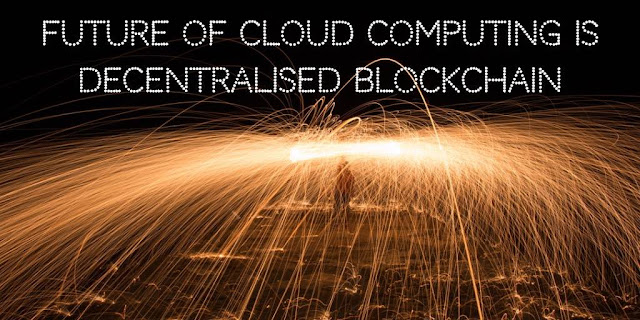Future of cloud computing is decentralised blockchain - Part 1
Future of cloud relies on shifting to decentralized network from centralized form factor. When we say future of cloud, we are not only predicting. Blockchain-based cloud is now a reality. In this article, Part-1 of series, we will see how blockchain is equipping and started shaping cloud computing.
We need to think about the blockchain, not just as a programmable infrastructure, but additionally as a network infrastructure of computing machinery. With that in mind, we can easily imagine how computer programs can operate on this new infrastructure that has been already used for transaction validations. But we shouldn't take the cloud computing analogy literally. The blockchain infrastructure does not replace cloud computing. It just transforms cloud infrastructure from centralized to truly distributed nature. Whenever you launch the application in the cloud, you're billed based on a combination of time, storage, data transfer and data rate requirements. The novelty with the virtual machine is that you run the company infrastructure in the cloud on a pay-as-you-go basis.
Consequently, the blockchain based cloud is a brand new layer. The infrastructure of blockchain resembles a layer of cloud computing infrastructure. However, blockchain layer does not let us replace cloud infrastructure. Blockchain VM's can be too costly if we're to literally compare their functionality to a typical cloud service like Amazon Web Services or Digital Ocean, but they are still useful for decentralized applications. In fact, central processing may still be required until edge devices become too powerful to process information as quickly as possible or in moments. As a side note, we can see a future where edge nodes or devices can communicate to one another directly where response time matters. e.g. driverless car wants to avoid many obstacles or accidents.
Having said this, there is a difficult part to run applications on this new infrastructure as applications are still not compatible with the decentralized concept of cloud infrastrucutre. The application demands to redesign the way they are working, i.e. reprogrammed to suit to blockchain platform. That work comes from the shape of adhering to a brand new paradigm of decentralized applications which follows a web3 architecture to run specifically on the blockchain.
We're going to create more data in 2018, than every year previous in history. Data is everything now, either it is your smartphone counting the number of steps you took today or your car's computer checking the engine or brake pads and analyzing data to suggest when maintenance is required. A self-driving machine can generate up to 1 gigabyte second, which after approximately 3 Minutes is more information than the largest storage choice on the iPhone currently, 256 GB. AWS, known as S3, Simple Storage Service, is the main frontrunner in the cloud, with Dropbox, Google Drive, IBM, and Microsoft's Azure competing for their share of the market, which carries on to grow.
The decentralized cloud storage vendors provide trustless, fault-tolerant, file storage service.
There are top decentralized cloud storage platforms identified in our research:
Sia – Decentralized Cloud Storage
 |
| Sia logo from website sia.tech |
Typically whenever you use cloud storage, your files are stored in a centralized data center owned by a company that uses the cloud storage platform. Sia, however, has a different idea of how to store your files and make use of millions of terabytes, or otherwise unused storage all over the world. By decentralizing their storage system they aim to create a more dependable cloud storage platform. As opposed to Hosting people's files in one information center, Sia may have other individuals Sign up as hosts to store your files. Anybody with a spare storage can act as a host, but they'll only get paid if they really do store the files.
The hosts have a blockchain based contract that makes sure that the files are being stored where the host says they're being stored. To ensure the security of user files, the files are processed using erasure coding. This means it's broken up into several smaller, encrypted pieces and made redundant. These smaller pieces are divided among multiple hosts. Since the files are also made redundant, just a few hosts out from the many hosts Sia hopes to have must be online in order for you to get at your files. Learn more at https://sia.tech/technology
This is definitely a brand New capture of cloud storage that will be intriguing to see play out. On their about page they estimate the service will cost about $6 for a TB of storage per month. They also make the bold claim that Sia will be the totally dominant service in the cloud storage marketplace. Do you believe Sia will be as strong as they expect? Would you like to act as a host? Would you use a cloud storage system in this way?
Filecoin - A Decentralized Storage Network
 |
| Filecoin storage snip from filecoin.io |
Filecoin, a project by Protocol Labs, is a decentralized storage network that turns a cloud storage in an algorithmic market. Miners earn Filecoin by providing storage to customers. And customers spend Filecoin employing miners to store or Distribute Data. Storj, listed below, and Sia coin based on the comparable concept. Filecoin shared its original white paper in July 2014, where it suggested a distributed electronic currency comparable to Bitcoin. The distinction Between Filecoin and bitcoin differed from Bitcoin's calculation just proof-of-work, Filecoin's proof-of-work function comprises a proof-of-retrievability part, that requires nodes to prove they store a certain file.
Most proof-of-retrievability schemes involve two parties, a customer who preprocesses data and a server who stores the processed information. At any stage, the client can issue a challenge to the server, that must then calculate the corresponding evidence. Typically, the challenges are generated and verified utilizing a secret key known only to the client. The Filecoin network forms a fully distributed file storage system, whose nodes are incentivized to store as much of the entire network's information as they can. The coin is granted for file storage and is transferred into transactions, as in Bitcoin. Filecoin is introduced with the release of the new white paper on August 04, 2017 only a month later at the release of the "'Filecoin Research Roadmap" for 2017.
Maidsafe: A New Decentralized Internet
 |
| Maidsafe snip from maidsafe.net |
The storage space is supplied by members of the network and comprises a small amount of space on their individual computers. These small, volunteered data storage spaces are part of the network. When the data is stored, there is no single storage node receives all the data, but only a part. The information is scattered among the entire network, that suggests there isn't one complete file that may be stolen, vandalized or otherwise compromised. All these data segments are protected by encryption, providing excellent protection from people having the ability interpret the content of the data. To take part In the network, one only volunteers a part of their computer as a storage space and uploads their information to the Maidsafe network, where it's shredded, encrypted and spread out among many computers make up the network.
This is really quite a clever way of eliminating the vulnerability that all data being stolen, copied or destroyed. The design prevents anyone who isn't a part of the network from accessing the information, and there are no 3rd parties involved with housing the data. The network is totally made up of those who want to participate in it.
Storj - a decentralized storage cloud
 |
| Storj snip from website storj.io |
Storj also seeks to change the meaning of cloud storage. The cloud is a term that represents something new and sophisticated, but traditional cloud storage services are simply using technology that has already existed for years prior, connecting to a host server and uploading\/downloading data freely isn't exactly new. Also, with a host server, there's A constantly present central point of failure and an easy political target. These factors do not exactly chime well with an amorphous entity as a cloud.
In addition, theoretically cloud services like Google Drive and Dropbox - can see everything that you transfer onto their servers. If governments coerce these organizations enough. They too will get access to your privately stored items. If you do not want the above to happen, then you might wish to anticipate this type of decentralized solution.
The idea is same as previous three projects that we listed above, is to rent out unused harddrive space around the globe, which there's a lot of. Think about the desktop you've at home, you can turn it into an asset generating asset.
Part 2 : Stay Tuned.
There is still more ground to cover. In part 2 of this series, we will see few more projects that are enabling cloud on blockchain.Subscribe to be the first to know once we publish next article in this series.
PC: pablo, unsplash
Never miss an update. Subscribe and follow to stay informed. Delivered Every Tuesday.
We hate spam too, we will never share your details.

Mandar Pise
Opinions expressed by techsutram contributors are their own. More details
Mandar is a seasoned software professional for more than a decade. He is Cloud, AI, IoT, Blockchain and Fintech enthusiast. He writes to benefit others from his experiences. His overall goal is to help people learn about the Cloud, AI, IoT, Blockchain and Fintech and the effects they will have economically and socially in the future.
Weekly Newsletter
Never miss an update. Subscribe and follow to stay informed.
Delivered Every Tuesday.
Delivered Every Tuesday.
Thank you! You have successfully subscribed to our newsletter.
We hate spam too, we will never share your details.




.jpg)
.jpg)
No comments:
Post a Comment
Your valuable comments are welcome. (Moderated)